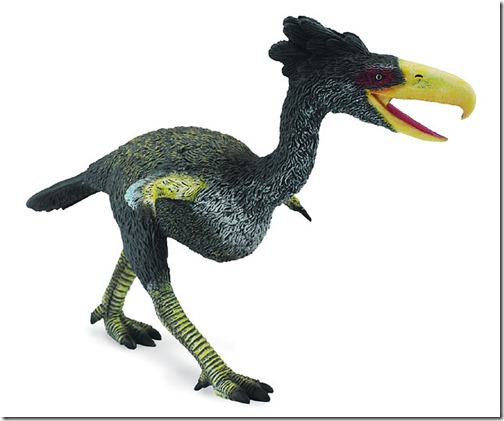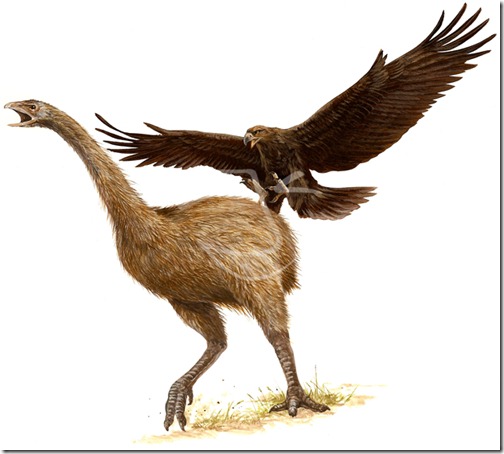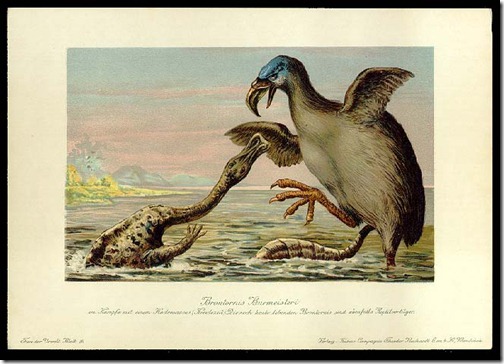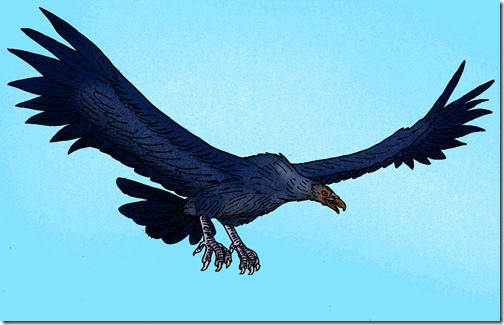What you need to understand is that these birds do not exist anymore. They went extinct along with the dinosaurs (some after them and some quite near to our time). I am sure you must be familiar with the most dangerous birds in the modern world so I decided to create a list about the birds that would haunt the skies, waters and grounds in the pre-historic world. Many different things were considered while compiling this particular list including speed, size and prey. I hope this list proves informational and educational. Enjoy the read!
10. TITANIS

This particular bird is said to have been flightless. It is extinct now but according to the fossils it was very large and carnivorous. It lived somewhere in the Northern America during the Blancan stage and died during the Gelasian age. So technically, the bird lived around 5 to 2 million years ago. The name of the bird comes from the Greek Gods that preceded the Twelve Olympians called the Titans. It belongs to the family of Phorusrhacidae and is classified as Aves. The bird was 2.5 meters tall and weighed around 150 kilograms.
9. PHYSORNIS

This used to be a predatory bird. They are considered to be one of the terror birds that used to live in Argentina. Physornis was a flightless bird and the only known species belonging to this family is Physornis fortis. It lived around 28 to 23 million years ago. They belong to the family of Phorusrhacidae and were classified as Aves. Unfortunately not a lot of information have been gathered on this particular bird but it still is considered to have been significantly dangerous.
8. MERRIAM’S TERATORN

The wingspan of this particular bird is said to have been around 3.5 to 3.8 meters covering an area of 17.5 square meters. It used to stand around 30 inches or 1 foot in height and weighed around 15 kilograms. It used to live in the Northern America. A closer relative to this bird was Aiolornis that used to be around 40% larger than this specie. Merriam’s Teratorn belongs to the family of Teratornithidae and is classified as Aves. Many fossils of this particular bird have been found in Califronia, Arizona and Floria.
7. PARAPHYSORNIS

This bird belongs to the family of Phorusrhacidae and is classified as Aves. This specie is considered as one of the terror birds flying the skies of prehistoric times. This was a predatory bird and it was flightless. They used to stand around 2 meters in length and just the skull spanned 60 centimeters. The bird lived around 23 million years ago. Its fossils were found in Brazil. The only known species of this particular bird is called Paraphysornis Brasiliensis. They were carnivorous and weighted around 200-250 kilograms.
6. OSTEODONTORNIS

This happens to be a seabird. Pelicans and storks are perhaps one of the closest relatives of these pre-historic birds. There species are said to have lived somewhere in Europe but their fossils were also discovered from parts of Canada. They are classified as Aves and belong to the family of Pelagornithidae. They were said to have had a wing span of around 6 meters and reached a height of 1.2 meters on the ground. They had very light bodies and probably webbed feet and narrow wings. The beak was around three quarters of the length of their head.
5. PHORUSRHACOS

These happen to have been very large, predatory and flightless birds living in Patagonia. With only one specie, Phorusrhacos Longissimus, they are probably very close relatives of the seriema birds. They were considered to be one of the terror birds haunting the woods and the grasslands. These birds stood around 2.5 meters in height and weighed around 130 kilograms. They would usually grasp their prey in their beaks and smash it to the ground repeatedly in order to kill it. They belong to the family of PHorusrhacidae and are classified as Aves.
4. KELENKEN

The family of Phorusrhacidae is basically known as terror birds and the kelenken belonged to that family. They were classified Aves. These birds were flightless and predatory. It was one of the largest carnivorous birds of all time. They could reach 3 meters in height and would usually weight somewhere around 220 to 250 kilograms. These birds are said to have lived some 15 million years ago in the Middle Miocene in Argentina. Their skull was around 28 inches long that included an 18 inch beak as well. The bird has one of the largest heads in the world.
3. HAAST’S EAGLE

These birds were massive and once lived in the southern islands of New Zealand. They are the largest eagles to ever exist in human knowledge. They would usually prey on giant flightless birds (a number of whom were discussed earlier). Their speeds could reach somewhere around 50 mph. These birds actually went extinct somewhere in the 1400s which is fairly close to our time if you compare it with other birds. They belong to the family of Accipitridae and are classified as Aves. They usually weighed somewhere between 9 to 16 kilograms depending on the gender with the females being much lighter.
2. BRONTORNIS

These were giant predatory birds to have lived in Patagonia. They would reach a height of 2.8 meters and weight in at around 350 to 400 kilograms. If you consider the human knowledge, these birds happen to be the third-heaviest birds. Considering the weight, they probably ambush their prey because it is safe to assume that they probably weren’t very agile. They belong to the family of Phorusrhacidae and are classified as Aves as most of the birds discussed in the list.
1. ARGENTAVIS

This happens to be the largest flying bird that has ever been discovered by humans. Its actual name is Argentavis Magnificens which means the magnificent Argentine bird. Good samples of fossils of this bird were obtained from Argentina. Their wingspan was around 7 meters, body length reached 1.3 meters, height reached 2 meters and they would usually weigh in on 80 kilograms. They belong to the family of Teratornithidae and are classified as Aves.